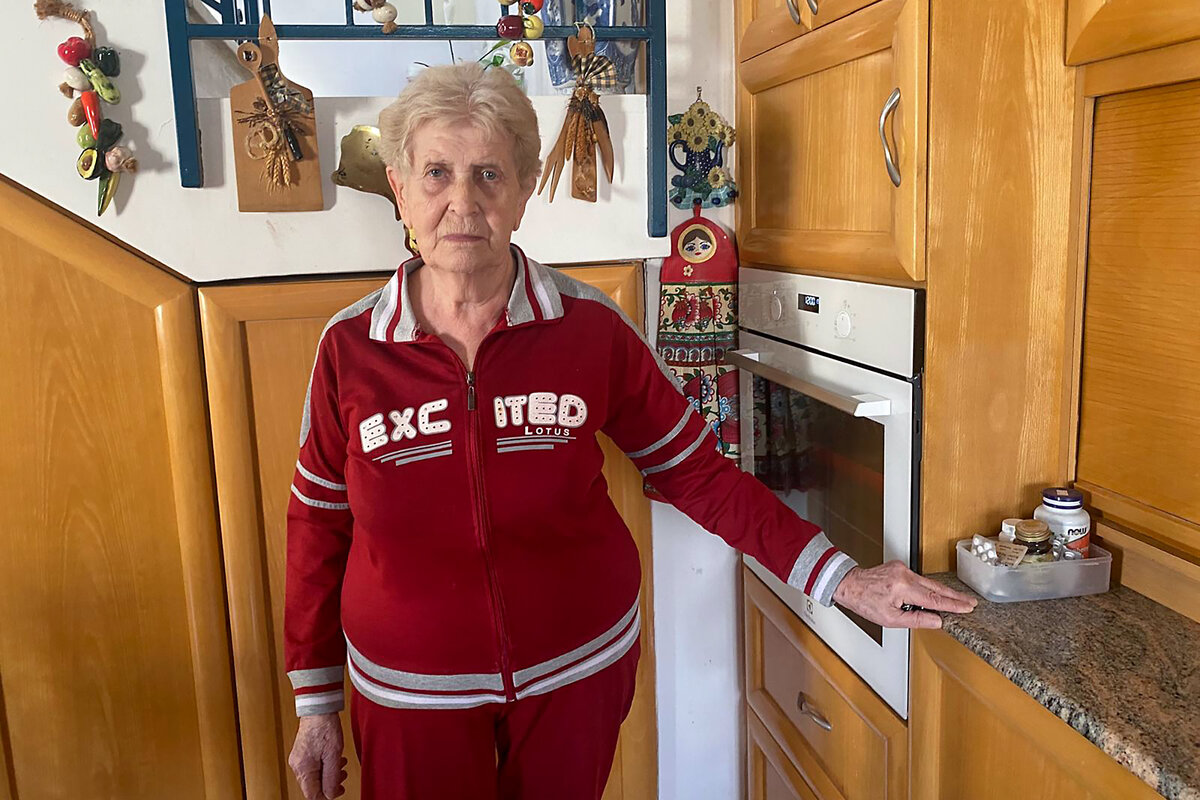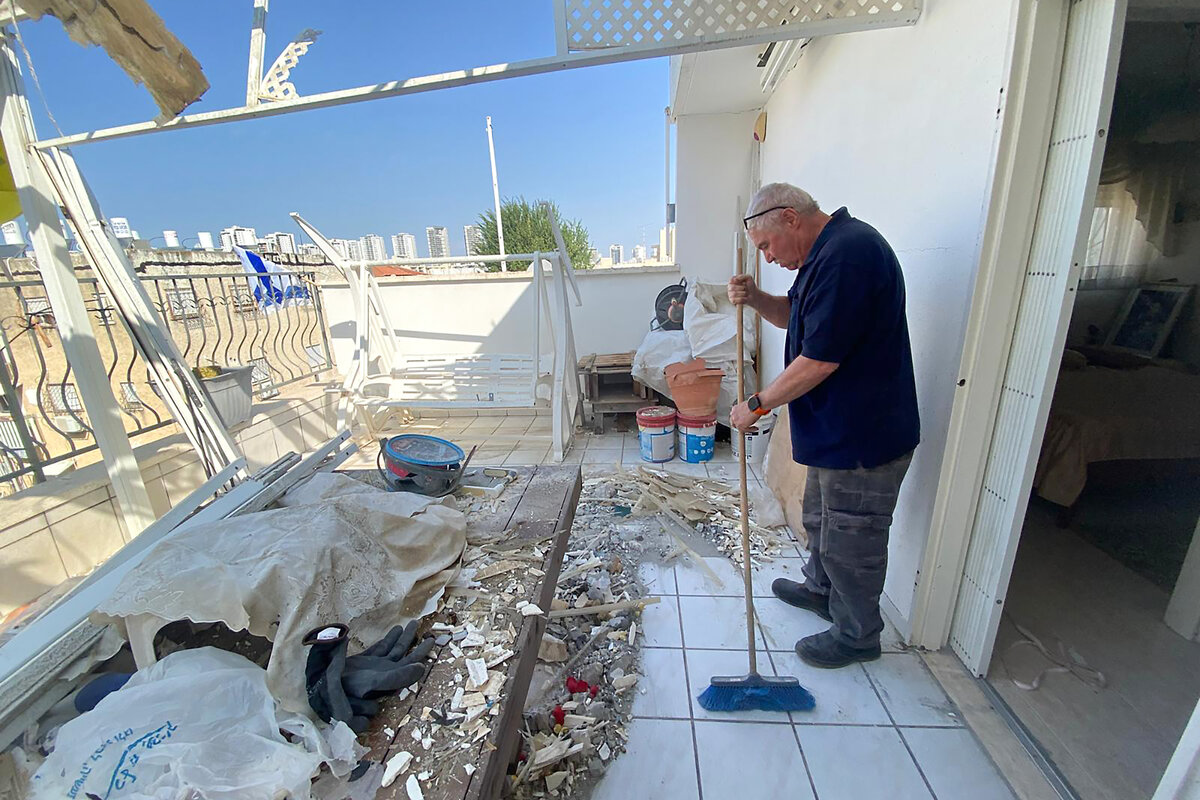When Hezbollah rockets are incoming, and you can’t reach the shelter
Loading...
| Kiryat Motzkin, Israel
Lusi Shinder was in her living room watching the news on television last week when she heard the unmistakable wail of an air raid siren. It has become a near-daily occurrence over the last two months in this northern Israeli community, but it is always jarring.
Heart pounding, she rose and clutched her walker, making her way down the hall to a protected room. She had just closed its door when she heard a boom so loud she knew immediately her building had been hit.
“I came out, and I was in shock. I was like a robot. I saw shattered glass, chunks of debris, smoke,” she says.
Why We Wrote This
A story focused onHezbollah’s intensified rocket barrages against northern Israeli communities have created two conflicting impulses among residents: They support the war against Hezbollah, yet are eager for it to end.
A rocket fired by Lebanon’s Hezbollah militia had crashed through her roof, leaving a gaping hole and a staircase coated in dust and chunks of concrete. Later she saw the rooftop pergola – under which she and her family had hosted holiday meals and birthday celebrations – hanging in shards, rubble everywhere.
For Ms. Shinder, who was born in a ghetto during World War II, and grew up in what is now Ukraine before immigrating to Israel just weeks before the 1973 Yom Kippur War, conflict has been the backdrop of her life.
But as Hezbollah’s fire has increased and reached deeper into northern Israel, what she and others are experiencing is, she says, “another level” – missiles and drones intercepted overhead or hitting residential areas like her own, people running to shelters, hillsides and cars burning, the ground shaking.
Across northern Israel, where schools only recently reopened, nature reserves remain closed. In Kiryat Motzkin, a suburb of the port city of Haifa, the zoo remains shuttered, as does its popular theater. All public events have been canceled.
One thinks twice before meeting a friend for coffee, and says a prayer before heading out on the roads. Businesses are suffering.
Support for war ... and its end
Residents say they are anxious for the war with Hezbollah to end. It began over a year ago when the Iran-backed Lebanese militia – in solidarity with its Palestinian ally Hamas the day after its brutal Oct. 7 assault – began firing into northern Israel, driving 65,000 people from their homes.
At the same time, most say they support Israel’s ground invasion of southern Lebanon to root out Hezbollah’s weapons-laden tunnels and hideouts, and push its forces farther from the border. Otherwise, the residents fear, Hezbollah could carry out a version of the massacre and mass hostage-taking that occurred along the border with Gaza.
In September, after nearly a year of incremental escalation along the Lebanon-Israel border, Israel dramatically intensified its campaign, assassinating much of Hezbollah’s leadership, including Hassan Nasrallah, killing and wounding hundreds of its operatives, and striking deeper inside Lebanon.
Hezbollah expanded its fire and threatened to make Haifa, Israel’s third-largest city and an important industrial base, into “the next Kiryat Shmona,” a reference to an Israeli border city in the Upper Galilee that for years has taken the brunt of Hezbollah barrages.
On Ms. Shinder’s roof, repairman Zeev Glabauch hoists a door that was warped and bent from the force of the blast onto his back.
“It’s terrible. They keep firing at us to show us they still can, even after Nasrallah has been killed,” he says. “It does not matter what deals you might make with them; they don’t want us here. They want this state for themselves,” he adds, referring to both Hezbollah and Hamas and recent efforts to secure a cease-fire deal with Hezbollah in Lebanon.
One minute to find shelter
Mr. Glabauch lives in a next-door Haifa suburb called Kiryat Bialik, part of a cluster of communities known collectively as the Krayot that have experienced the intensified Hezbollah fire. One of the apparent targets is Rafael, a weapons manufacturer.
On Monday some 100 rockets were fired at the Krayot in one of the conflict’s largest barrages. Two buildings were hit, and nine people were wounded. Plumes of black smoke billowed into the sky from a normally quiet street where several cars caught fire.
On Tuesday two people were killed further to the northeast, in the Galilee. Two soldiers were wounded by a drone Thursday south of Haifa, and three people were wounded in Kiryat Bialik Friday.
Mr. Glabauch lives in an eight-story apartment building where residents of its 32 units share a single bomb shelter in the basement. He lives on the fifth floor, and typically with only about a minute to get to safety, he and his wife must seek shelter instead in the stairwell along with their upper-floor neighbors.
“We run to the stairs. This is our life. Along with dogs, babies, children, and all the noise,” he says. When awoken by sirens, they rush there in pajamas.
But most of all, he says, he fears driving on the roads, where there is nothing to do in the moment of an attack but stop the car, find a sidewalk or shoulder to lie down on, and cover one’s head.
Jewish Israelis are not the only ones affected by the Hezbollah barrages.
Laura Samara, a film producer, is a Palestinian citizen of Israel who lives in Haifa. She says she does not identify with Hezbollah or Hamas. Rather, she relates more “to the misery of the people.”
“The thing I feel most is that everything is on hold. You cannot plan things,” she says. “You wake up in the morning, and you are waiting for the siren.
“It takes place usually once or twice a day, and you want it over so you can do things like go to the supermarket. The crazy thing is it feels like a lottery – you don’t know if a fragment of a missile or a missile will hit you.”
“All in the same boat”
In Haifa’s Arab neighborhood of Wadi Nisnas, a place of narrow alleyways and stone houses where neighbors regularly share coffee and homemade cookies, some are outspoken against Hezbollah.
“To live here is very hard,” says Fiaruz Hashem, sitting in the stone courtyard of her sister’s home. “My grandchildren are scared when they hear a siren and go where they are told to hide – the safest place, which is in their hallway.
“I’m angry at Hezbollah,” she says, “not just because of what we are suffering, but that the Lebanese have to suffer like this too because of them.” Since the fighting intensified, some 3,000 Lebanese, both civilians and combatants, reportedly have been killed in the Israeli campaign.
Eman Siback lives in the northern Arab town of Shfaram, which like most others has no bomb shelters. She and her husband seek safety in their bedroom, surrounded by other rooms, making it the most secure spot in their home. The town is mourning for a mother and son who went out to harvest olives last week and were killed by rocket fire.
“It shows we are all in the same situation whether we are Arab, Jewish, Druze, young, old, male, or female,” she says. “We are all in the same boat, and it feels like things are only deteriorating.”








